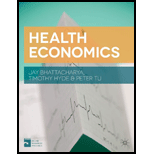
Health Economics
14th Edition
ISBN: 9781137029966
Author: Jay Bhattacharya
Publisher: SPRINGER NATURE CUSTOMER SERVICE
expand_more
expand_more
format_list_bulleted
Expert Solution & Answer
Want to see the full answer?
Check out a sample textbook solution
Students have asked these similar questions
Which of the following statements is FALSE regarding the concept of "adverse selection"?
Multiple Choice
Adverse selection describes a situation where an individual's demand for insurance is positively correlated with the individual's risk of loss.
Adverse selection occurs when someone increases their exposure to risk when insured. This can happen, for example, when a person takes more risks because someone else bears the cost of those risks.
The relationship between smoking status and mortality provides a good illustration for adverse selection, especially in the case in which a life insurance company did not vary its premiums according to smoking status of its customers.
To counter the effects of adverse selection, insurers may offer premiums that are proportional to a customer's risk.
Indicate whether the statement is true or false, and justify your answer.In the Rothschild–Stiglitz model, an individual who is offered a choice between full insurance and no insurance will always choose full insurance if they are risk-averse.
Indicate whether the statement is true or false, and justify your answer.Even though it is illegal for sickness funds to deny coverage to individuals, insurers still often engage in risk selection.
Chapter 10 Solutions
Health Economics
Knowledge Booster
Similar questions
- Indicate whether the statement is true, false, or unclear, and justify your answer.The fact that high-risk customers are usually less risk-averse than low-risk customers helps counteract adverse selection.arrow_forwardIndicate whether each statement is true or false, and justify your answer.Insurance mandates do little to combat the problem of adverse selection.arrow_forwardProvide an intuitive discussion of how adverse selection affects the used-car market. Describe one potential signal that can help alleviate the problem of adverse selection in this market and discuss how this signal satisfies the two necessary assumptions for it to be used as a credible signal.arrow_forward
- Indicate whether the statement is true or false, and justify your answer.Patients are charged premiums based on their risk rating.arrow_forwardIndicate whether the statement is true, false, or unclear, and justify your answer.Moral hazard is mostly a problem in countries with universal insurance programs like the UK.arrow_forwardIndicate whether the statement is true or false, and justify your answer.In an actuarially fair insurance contract, the insurance premium equals the probability of sickness times the payout amount.arrow_forward
- Indicate whether the statement is true, false, or unclear, and justify your answer.Ex post risk is typically much lower than ex ante risk because uncertainty is largely eliminated by the purchase of an insurance contract.arrow_forwardMultiple Choice Adverse selection describes a situation where an individual's demand for insurance is positively correlated with the individual's risk of loss. Adverse selection occurs when someone increases their exposure to risk when insured. This can happen, for example, when a person takes more risks because someone else bears the cost of those risks. The relationship between smoking status and mortality provides a good illustration for adverse selection, especially in the case in which a life insurance company did not vary its premiums according to smoking status of its customers. To counter the effects of adverse selection, insurers may offer premiums that are proportional to a customer's risk.arrow_forwardWhich of the following is NOT predicted by the asymmetric information models? Pooling between different risk types cannot survive in the long run. There will be a positive correlation between riskiness and insurance coverage. Insurers will use bulk markup in their pricing strategies. Insurers will use bulk discount in their pricing strategies.arrow_forward
- Consider the model of competitive insurance discussed in lectures (Topic 6.7). Peter is a risk averse individual with the utility function u(w) = w0.5. His current wealth is $300 and with probability 1/2 he will incur a loss of D = $240, but with probability 1/2 he will incur no loss. Ann has the same utility u(w) = w0.5 and current wealth $300 as Peter, but a different probability of loss: she will incur a loss of D = $240 with probability 0.1, and no loss with probability 0.9. As we showed in lectures, in the separating equilibrium Peter is offered actuarially fair full insurance contract, so his wealth is equal to $180, whether loss happens or not. Ann will be offered an insurance contract with the amount of insurance (approximately) equal to Group of answer choices 0 16 36 66 120 240arrow_forwardIndicate whether the statement is true, false, or unclear, and justify your answer.Cawley and Philipson (1999) find that, in life insurance markets, there is a bulk discount (that is, people buying larger policies pay lower per unit prices). They conclude that this finding is inconsistent with the Rothschild–Stiglitz model.arrow_forwardIndicate whether the statement is true or false, and justify your answer.To date, no major health insurance experiment has studied the impact of uninsurance, just different levels of insurance.arrow_forward
arrow_back_ios
SEE MORE QUESTIONS
arrow_forward_ios
Recommended textbooks for you
 Managerial Economics: A Problem Solving ApproachEconomicsISBN:9781337106665Author:Luke M. Froeb, Brian T. McCann, Michael R. Ward, Mike ShorPublisher:Cengage Learning
Managerial Economics: A Problem Solving ApproachEconomicsISBN:9781337106665Author:Luke M. Froeb, Brian T. McCann, Michael R. Ward, Mike ShorPublisher:Cengage Learning

Managerial Economics: A Problem Solving Approach
Economics
ISBN:9781337106665
Author:Luke M. Froeb, Brian T. McCann, Michael R. Ward, Mike Shor
Publisher:Cengage Learning